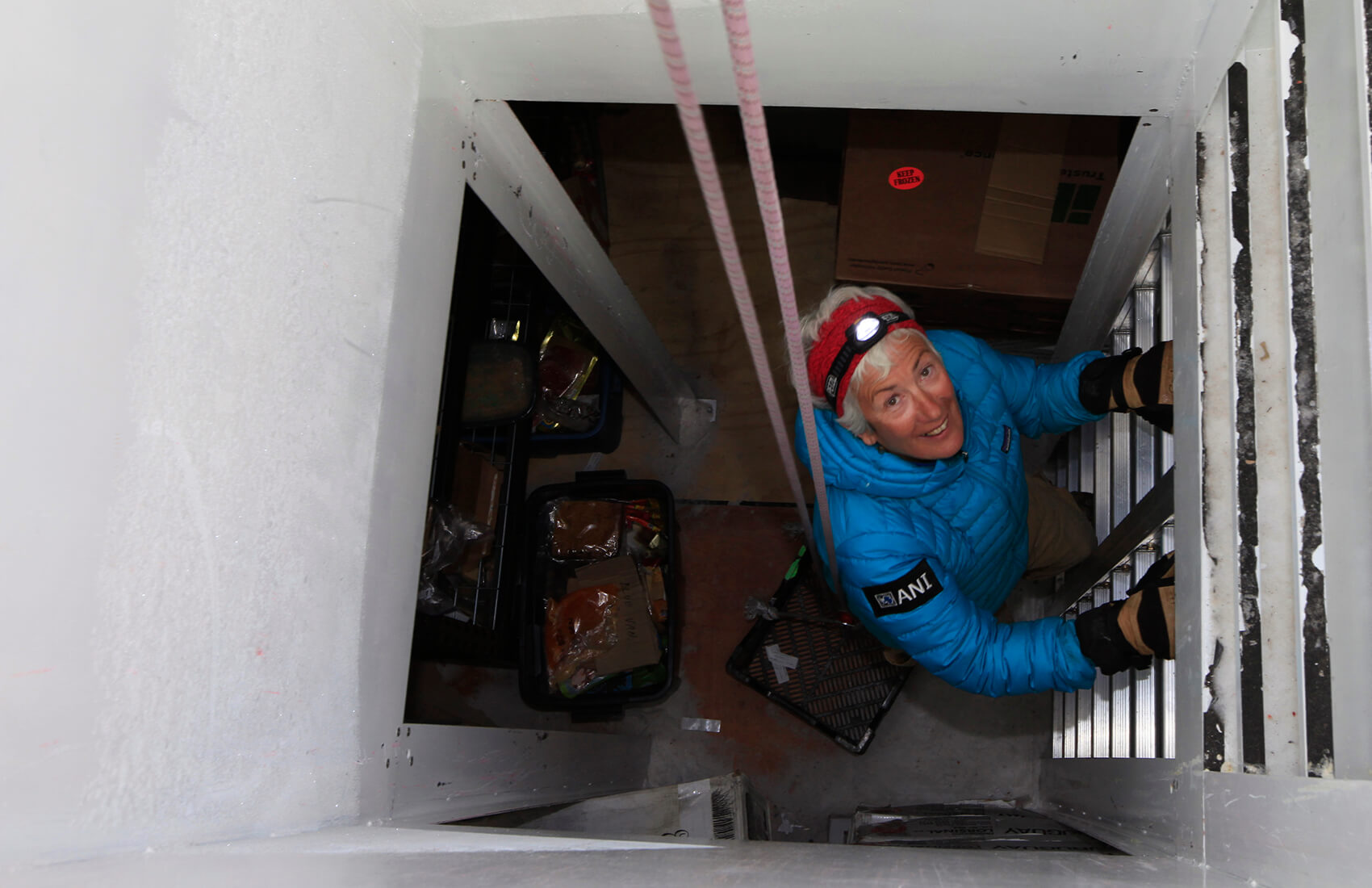Believe it or not, keeping things cool – or even frozen – in Antarctica can be a real challenge. Difficulties include fluctuating temperatures due to variations in the sun’s energy and the realities of living on a moving glacier, in the most remote corner of the globe. The trick is keeping things at the right temperature and easily accessible.
Keeping Cool in the Antarctic Freezer
Fresh fruits and vegetables
[column-group][column]
During the summer there is 24 hour daylight and the warming effect of the midday sun can be intense. At the ‘night time’ hours, on cloudy days, or when the sun drops behind a mountain, temperatures can plummet. Indoor temperatures in unheated tents range from midday highs of 15-20C (60-68F) to ‘nighttime’ lows at or below freezing. Foods stored in an unheated tent may freeze or spoil due fluctuating temperatures.
At Union Glacier base camp we have an insulated, heated ‘chiller box’ (pictured left) that keeps ‘freshies’ at an even, cool temperature. But in the field, the only way to keep fresh vegetables from freezing at night is to put them in your sleeping bag. I can vouch for the fact that it is – well um – interesting – crawling into a sleeping bag stuffed with cabbages, carrots, and potatoes. And it’s even more interesting trying to convince your colleagues to take their share of vegetables to bed!
[/column][/column-group]Supply and Demand – How many for supper?
[column-group][column]There is also the problem of supply and demand. Union Glacier is many thousands of miles from the nearest store. Foods are ordered in bulk from suppliers in Chile, then flown to the ice roughly once a week. All flights are weather dependent and so we are seldom sure exactly how many guests there will be for dinner, or when the next order of freshies will arrive. Our chefs must plan carefully and be prepared to improvise!
Winter is another matter entirely. Union Glacier doesn’t operate during the Antarctic winter months, but some scientific stations do. Fresh foods are limited or non-existent, since cold temperatures and frozen seas prevent supply flights or ships from reaching the stations. McMurdo and Amundsen-Scott South Pole Station have greenhouses, where they produce fresh salad greens and herbs throughout the winter. The McMurdo greenhouse generates up to 140 kg of food each month, enough for the 200-odd residents to have salad a couple of times a week. To comply with the Antarctic Conservation Act, everything at these stations is grown hydroponically. More about the McMurdo greenhouse
[/column][column]
Frozen Foods – Snow and ice caves, in the footsteps of Amundsen
It may seem counter-intuitive, but keeping things frozen is also an issue. Goods stored above ground will thaw then freeze with the cycles of the sun. An obvious solution is to store them underground in a snow or ice cave. Both Scott and Amundsen used this system on their South Pole expeditions.
[column-group][column]Amundsen’s Ice Cave

In his book, Amundsen described the inside of their ice cave.
‘Lindström…had put everything in splendid order. In the covered passage round the hut he had cut out shelves in the snow and filled them with slices of seal meat…On the outer walls of the hut, which formed the other side of the passage, he had put up shelves, and there all kinds of tinned foods were stored. All was in such perfect order that one could put one’s hand on what one wanted in the dark. There stood salt meat and bacon by themselves, and there were fish-cakes.’
Unfortunately the order didn’t last.
‘The provision passage turns our days into chaotic confusion. How my mind goes back to the time when one could find what one wanted without a light of any kind! If you put out your hand to get a plum-pudding and shut it again, you could be sure it was a plum-pudding you had hold of. And so it was throughout Lindström’s department. But now — good Heavens! I am ashamed to put down what happened to me yesterday. I went out there in the most blissful ignorance of the state of things now prevailing, and, of course, I had no light with me, for everything had its place. I put out my hand and grasped. According to my expectation I ought to have been in possession of a packet of candles, but the experiment had failed. That which I held in my hand could not possibly be a packet of candles. It was evident from the feel that it was something of a woollen nature. I laid the object down, and had recourse to the familiar expedient of striking a match. Do you know what it was? A dirty old — pair of pants! and do you want to know where I found it? Well, it was between the butter and the sweetmeats. That was mixing things up with a vengeance.’
[/column][column]Modern Ice Caves

Argentina’s Belgrano II station has a beautiful blue-ice cave. The ice is chipped to provide drinking water for the station and the resulting network of tunnels are used for storage, a museum and even a chapel. Photos of Belgrano II ice cave.
ALE also used an ice cave at Patriot Hills camp (pictured above). The cave was covered by a wooden trapdoor and had snow steps leading down to a storage area consisting of several tunnels. A trip to the ice cave was an expedition that could take minutes, or hours, depending on whether the trapdoor was snowed in and whether you could find a shovel to clear it! Originally, candles were the only light-source and ‘shoppers’ could count on finding a stash of candles and matches at the base of the stairs. Later, solar-powered fairy lights were added to the cave. As in Amundsen’s day, those who were familiar with the cave’s layout and storage system didn’t need lighting. It was enough to feel along the rows of supplies, knowing that the third case on the left held tins of powdered milk or the last stack of boxes on the right were cuts of beef.
The trouble with ice caves
The Patriot Hills ice cave needed regular maintenance. Snow accumulation buried the cave deeper and deeper under the ice, thus increasing the number of slippery snow steps that had to be navigated. Each year the ceiling needed to be re-shaped and raised by cutting away snow blocks and hauling them up out of the cave – a monumental task. Safety was also a concern, with heavy loads being hoisted up and down the slippery steps.
[/column][/column-group]How cold is too cold?
 Goods buried under the ice are not only hard to access, they are really, really frozen. Home freezers generally keep foods at -18C (0F), but the year-round temperature in the Patriot Hills ice cave was about -28C (-18F). Frozen foods took several days to thaw and it wasn’t unusual to find tins of tomatoes or other canned goods defrosting on top of the hot water tank to hurry them along.
Goods buried under the ice are not only hard to access, they are really, really frozen. Home freezers generally keep foods at -18C (0F), but the year-round temperature in the Patriot Hills ice cave was about -28C (-18F). Frozen foods took several days to thaw and it wasn’t unusual to find tins of tomatoes or other canned goods defrosting on top of the hot water tank to hurry them along.
Improved Freezer Systems
After the move to Union Glacier ALE installed an improved under-ice storage container with a mechanized lift. Even this has its challenges however, as the container is gradually buried by accumulating snow and has to be brought back to the surface periodically, before the movement of the glacier deforms or crushes the under-ice structure.
A new purchase for Union Glacier Camp in 2014 was a large, above-ground, commercial freezer container on skids. The above-ground freezer provides ample storage space, in a convenient, temperature-controlled environment that is easy to relocate. We’ve come a long way since Amundsen and the early days of ALE!





